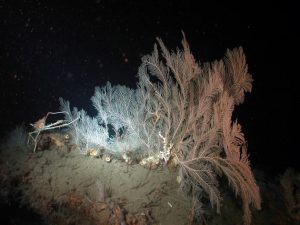Smithsonian Slideshow Features ECOGIG Deep-Sea Coral Research
– January 21, 2015
After the Deepwater Horizon incident, scientists faced the daunting task of locating deep-sea coral communities on the Gulf seafloor and assessing their condition.
The Smithsonian has published a slideshow providing a glimpse into the challenges ECOGIG scientists faced when investigating Deepwater Horizon oil spill’s impacts on deep-sea Gulf corals. This research is part of a broader ECOGIG effort to understand the impacts of natural oil seepage versus those of large spills in the Gulf of Mexico.
The Ocean Portal slideshow shares stunning images of Gulf coral, fascinating underwater research equipment, and scientists’ descriptions of their work.
To learn more:
- Study Shows Extended Footprint of Oil Spill Impact on Corals highlights recent peer-reviewed findings
- Biologist Chuck Fisher describes how researchers found the corals and what they are learning about their condition in this video: ECOGIG Deep Sea Life: Corals, Fish Invertebrates.
- Watch researchers aboard the E/V Nautilus use the remotely operated vehicle Hercules to capture high-resolution coral images near the Deepwater Horizon site shortly after the incident in this video: ECOGIG: Imaging Deep-sea Corals.
- A series of blogs by researchers who returned to the coral sites in 2014 describe some unexpected creatures they saw, including the “Five Weirdest Deep Sea Drifters” and a “Vampire Squid.”
***********
GoMRI and the Smithsonian have a partnership to enhance oil spill science content on the Ocean Portal website.
This research was made possible in part by a grant from BP/The Gulf of Mexico Research Initiative (GoMRI) to the Ecological Impacts of Oil and Gas Inputs to the Gulf (ECOGIG). The GoMRI is a 10-year independent research program established to study the effect, and the potential associated impact, of hydrocarbon releases on the environment and public health, as well as to develop improved spill mitigation, oil detection, characterization and remediation technologies. An independent and academic 20-member Research Board makes the funding and research direction decisions to ensure the intellectual quality, effectiveness and academic independence of the GoMRI research. All research data, findings and publications will be made publicly available. The program was established through a $500 million financial commitment from BP. For more information, visit https://gulfresearchinitiative.org/.
© Copyright 2010- 2017 Gulf of Mexico Research Initiative (GoMRI) – All Rights Reserved. Redistribution is encouraged with acknowledgement to the Gulf of Mexico Research Initiative (GoMRI). Please credit images and/or videos as done in each article. Questions? Contact web-content editor Nilde “Maggie” Dannreuther, Northern Gulf Institute, Mississippi State University (maggied@ngi.msstate.edu).






